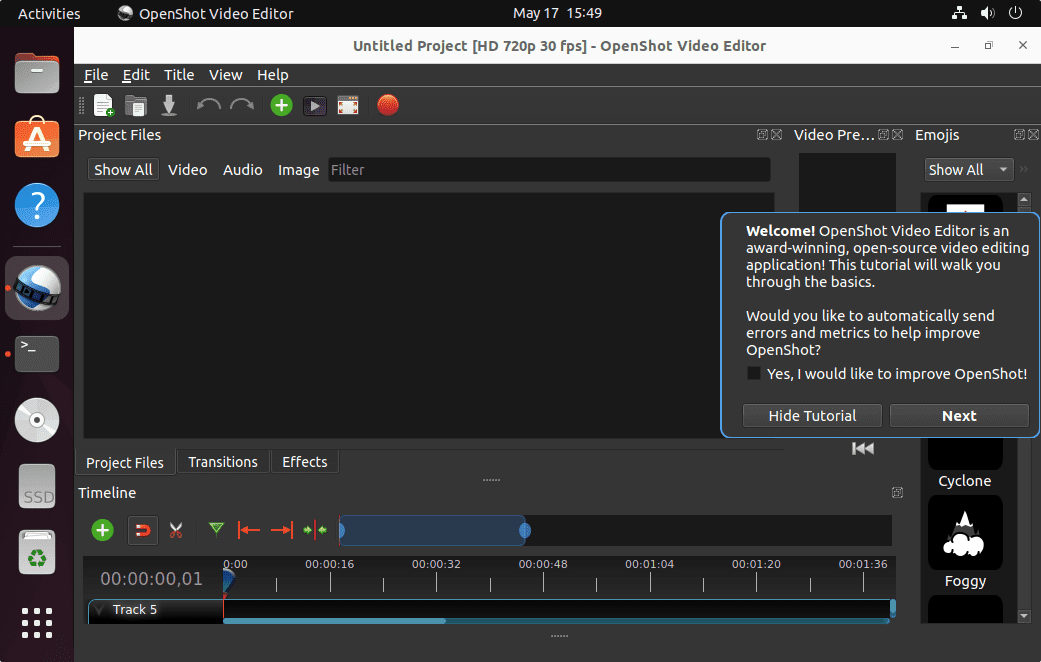How To Install OpenShot on AlmaLinux 10

OpenShot Video Editor stands as one of the most popular free, open-source video editing solutions available for Linux systems today. This comprehensive guide will walk you through multiple installation methods for OpenShot on AlmaLinux 10, ensuring you have a fully functional video editing environment ready for your creative projects.
Whether you’re a content creator, educator, or professional videographer, OpenShot offers powerful editing capabilities without the hefty price tag of commercial alternatives. The software supports a wide range of video formats, includes advanced features like hardware acceleration, and provides an intuitive interface that makes video editing accessible to users of all skill levels.
What is OpenShot Video Editor?
OpenShot Video Editor is a cross-platform, open-source video editing software that runs seamlessly on Linux, Windows, macOS, and Chrome OS. Built with Python and Qt, this powerful application enables users to create professional-quality videos, animations, and multimedia presentations without requiring expensive proprietary software.
The software excels in providing non-linear video editing capabilities, allowing users to combine multiple video clips, audio tracks, and images into cohesive projects. OpenShot supports numerous video, audio, and image formats through its integration with the FFmpeg library, making it compatible with virtually any media file you might encounter.
Key Features and Capabilities
OpenShot offers an impressive array of features that rival commercial video editing software. The application includes 3D animation capabilities, multiple track support, and advanced compositing tools. Users can apply video transitions with real-time previews, create custom titles and credits, and utilize over 20 built-in video effects including brightness adjustment, gamma correction, and chroma key (green screen) functionality.
The software’s drag-and-drop interface makes it particularly user-friendly for beginners, while its advanced features satisfy the needs of experienced editors. OpenShot also supports Blender integration for 3D animations and includes preset configurations for popular platforms like YouTube, Vimeo, and social media networks.
System Requirements and Prerequisites
Before installing OpenShot on AlmaLinux 10, ensure your system meets the minimum hardware and software requirements for optimal performance.
Hardware Requirements
OpenShot requires a 64-bit processor with multi-core support for optimal performance. While the software can run on dual-core systems, six or more cores are recommended for smooth editing of high-resolution videos. Memory requirements start at 4GB of RAM, but 16GB or more is strongly recommended for professional video editing workflows.
Storage requirements include at least 500MB of hard disk space for the basic installation, with additional space needed for project files and cache. A solid-state drive (SSD) significantly improves performance, particularly when working with large video files or enabling disk caching features.
Graphics and Display Requirements
Modern graphics hardware enhances OpenShot’s performance significantly. The software supports hardware acceleration for NVIDIA, AMD, and Intel GPUs, potentially improving rendering speeds by 30-40% when working with MP4/H.264 files. High-DPI displays are fully supported, ensuring crisp interface rendering on modern monitors.
Software Prerequisites
AlmaLinux 10 should be fully updated before beginning the installation process. You’ll need root or sudo access to install packages and configure repositories. An active internet connection is essential for downloading packages and dependencies.
Important Note: As of July 2025, AlmaLinux 10 may not be officially released. This guide adapts instructions primarily tested on AlmaLinux 9, which should be compatible with AlmaLinux 10 when it becomes available.
Pre-Installation System Setup
Proper system preparation ensures a smooth OpenShot installation and optimal performance.
System Updates and Repository Configuration
Begin by updating your AlmaLinux system to the latest packages and security patches:
sudo dnf clean all
sudo dnf updateThis process ensures your system has the latest security updates and package information.
Enabling Essential Repositories
OpenShot installation requires access to additional repositories beyond the standard AlmaLinux repositories. Enable the EPEL (Extra Packages for Enterprise Linux) and CRB (CodeReady Builder) repositories:
sudo dnf config-manager --set-enabled crb
sudo dnf install epel-releaseThese repositories provide access to additional packages and dependencies required for multimedia applications.
Installing Multimedia Dependencies
OpenShot relies on various multimedia libraries and codecs. Install the essential dependencies:
sudo dnf install ffmpeg ffmpeg-libs
sudo dnf install python3-qt5 python3-setuptoolsThese packages provide the foundation for video and audio processing capabilities within OpenShot.
Installation Methods Overview
OpenShot can be installed on AlmaLinux 10 through several methods, each with distinct advantages and use cases.
Method Comparison
Official Repository Installation provides the most integrated experience with automatic updates through the system package manager. This method ensures OpenShot receives updates alongside other system packages.
AppImage Installation offers a portable, self-contained solution that doesn’t require system-level installation. AppImages include all necessary dependencies and can run on virtually any Linux distribution.
Flatpak Installation provides sandboxed security and universal compatibility across different Linux distributions. Flatpak applications receive updates independently of the base system.
Method 1: Official Repository Installation
The official repository installation provides the most seamless integration with your AlmaLinux system.
Step-by-Step Installation Process
Install OpenShot directly from the AlmaLinux repositories using the DNF package manager:
sudo dnf install openshot-qtThis command downloads and installs OpenShot along with all required dependencies. The installation process automatically handles dependency resolution and ensures compatibility with your system.
Verifying Installation
After installation completes, verify OpenShot is properly installed by launching it from the terminal:
openshot-qtThe application should launch successfully, displaying the main interface with project files management, timeline editing area, preview window, and menu bar.
Desktop Integration
The repository installation automatically creates desktop entries and file associations. OpenShot will appear in your application menu under the “Multimedia” or “Audio & Video” category. The installation also configures proper MIME type associations for supported video formats.
Method 2: AppImage Installation
AppImage provides a portable installation method that doesn’t require system-level changes.
Downloading the AppImage
Download the latest OpenShot AppImage from the official website:
wget https://github.com/OpenShot/openshot-qt/releases/download/v3.3.0/OpenShot-v3.3.0-x86_64.AppImageAlternatively, visit the official OpenShot download page and manually download the AppImage file.
Making the AppImage Executable
Set executable permissions on the downloaded AppImage:
chmod +x OpenShot-v3.3.0-x86_64.AppImageThis step is crucial for the AppImage to function properly.
Running and Desktop Integration
Execute the AppImage directly:
./OpenShot-v3.3.0-x86_64.AppImageFor desktop integration, create a custom desktop entry or use the AppImage’s built-in integration features. The AppImage approach allows you to run multiple versions of OpenShot simultaneously without conflicts.
AppImage Advantages
AppImages offer several benefits including complete portability, no system dependency conflicts, and easy version management. Updates are handled by downloading new AppImage files rather than through system package managers.
Method 3: Flatpak Installation
Flatpak provides a universal packaging solution with enhanced security through sandboxing.
Installing Flatpak Runtime
Install Flatpak on your AlmaLinux system:
sudo dnf install flatpakAdd the Flathub repository for access to OpenShot:
sudo flatpak remote-add --if-not-exists flathub https://flathub.org/repo/flathub.flatpakrepoInstalling OpenShot via Flatpak
Install OpenShot from the Flathub repository:
sudo flatpak install flathub org.openshot.OpenShotLaunch OpenShot using Flatpak:
flatpak run org.openshot.OpenShotFlatpak Security Benefits
Flatpak applications run in sandboxed environments, providing enhanced security by limiting access to system resources. This isolation prevents applications from interfering with each other or accessing sensitive system files without permission.
Post-Installation Configuration
Optimize OpenShot’s performance and functionality through proper configuration.
Initial Setup and Preferences
Launch OpenShot for the first time to complete the initial setup wizard. The software may prompt you to configure language preferences, default project settings, and keyboard shortcuts. Take time to configure these settings to match your workflow preferences.
Hardware Acceleration Setup
Enable hardware acceleration for improved performance. Navigate to Edit > Preferences > Performance and select the appropriate hardware acceleration profile for your GPU. This setting can significantly improve rendering speeds for supported video formats.
Audio System Configuration
Configure audio settings by accessing Edit > Preferences > Preview and selecting the appropriate audio device. Common issues include missing audio during playback, which can often be resolved by adjusting the audio sample rate to match your source material.
Project Directory Setup
Establish a dedicated directory structure for your video projects. Create folders for raw footage, project files, exports, and cache to maintain organization. Configure OpenShot to use these directories through the preferences menu.
Basic Usage and Interface Overview
Understanding OpenShot’s interface components enables efficient video editing workflows.
Main Interface Components
OpenShot’s interface consists of four primary areas: the project files panel for managing media assets, the timeline for arranging clips, the preview window for viewing your work, and the properties panel for adjusting settings.

Creating Your First Project
Start a new project by selecting File > New Project. Import media files by dragging them into the project files panel or using the File > Import Files menu option. The software supports a wide range of formats including MP4, AVI, MOV, and many others.
Timeline Operations
The timeline provides the core editing functionality. Drag clips from the project files panel to the timeline to begin editing. Use the trim, cut, and split tools to edit clips precisely. OpenShot supports multiple video and audio tracks, allowing complex compositions.
Effects and Transitions
Access built-in effects and transitions through the Effects tab. OpenShot includes over 20 video effects and numerous transition options. Apply effects by dragging them onto clips in the timeline.
Performance Optimization and Advanced Tips
Maximize OpenShot’s performance through proper configuration and optimization techniques.
Memory and Cache Optimization
Adjust cache settings to improve performance. Navigate to Edit > Preferences > Cache and increase the cache size based on your available RAM. More cache memory results in smoother playback and faster rendering.
Preview Quality Settings
Reduce preview quality to improve real-time playback performance. Lower resolution previews reduce the processing load while maintaining editing precision. Adjust preview settings through the preview window controls.
Profile Selection
Choose appropriate project profiles based on your target output format. Smaller profiles require less processing power and provide smoother editing experiences. Configure profiles through Edit > Preferences > Profiles.
Proxy Media Usage
For large video files, consider using proxy media to improve editing performance. Proxy files are lower-resolution versions of your source material that maintain editing precision while reducing system load.
Troubleshooting Common Issues
Address common OpenShot installation and operational problems effectively.
Installation Problems
Repository Access Issues: If you encounter repository access problems, verify your internet connection and ensure the EPEL and CRB repositories are properly configured.
Dependency Conflicts: Resolve dependency conflicts by updating your system and clearing the DNF cache before attempting installation.
Permission Problems: Ensure you have appropriate sudo privileges for system-level installations. AppImage installations don’t require special permissions.
Performance Issues
High CPU Usage: Monitor system resources during video editing. Close unnecessary applications and reduce preview quality to improve performance.
Memory Problems: Insufficient RAM can cause crashes and poor performance. Consider upgrading system memory or using proxy media for large projects.
Graphics Issues: Update graphics drivers and enable hardware acceleration where supported to improve rendering performance.
Audio and Video Playback Problems
No Audio During Playback: Check audio device settings in OpenShot preferences and ensure your system audio is functioning properly. Verify that audio tracks are enabled on your video clips.
Codec Compatibility: Install additional codecs if you encounter unsupported format errors. The FFmpeg library handles most common formats, but some proprietary formats may require additional codecs.
Export Failures: Export failures often result from insufficient disk space or corrupted source files. Verify available storage and test with different export settings.
Advanced Features and Workflow Tips
Leverage OpenShot’s advanced capabilities for professional video editing.
Keyframe Animation
OpenShot’s keyframe system allows precise control over effects and transitions. The software can generate thousands of interpolated values for smooth animations. Access keyframe controls through the properties panel when working with effects and transitions.
Blender Integration
OpenShot integrates with Blender for advanced 3D animation capabilities. Install Blender alongside OpenShot to access 3D title templates and animated elements.
Color Correction and Grading
Utilize OpenShot’s color correction tools to enhance video quality. The software includes brightness, gamma, and hue adjustments, along with more advanced color grading options.
Multi-Track Editing
Take advantage of OpenShot’s multi-track timeline for complex compositions. Layer video, audio, and effects tracks to create professional-quality productions.
Congratulations! You have successfully installed OpenShot. Thanks for using this tutorial to install the latest version of the OpenShot Video Editor on AlmaLinux OS 10. For additional help or useful information, we recommend you check the official OpenShot website.